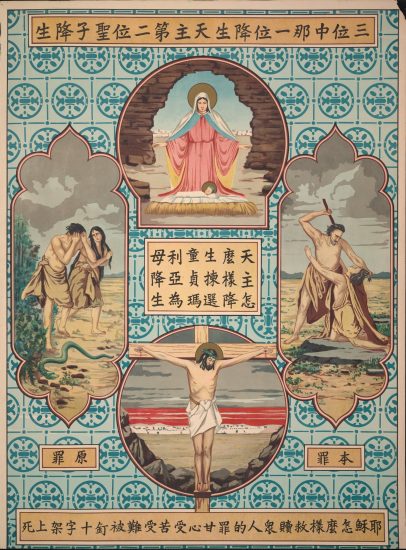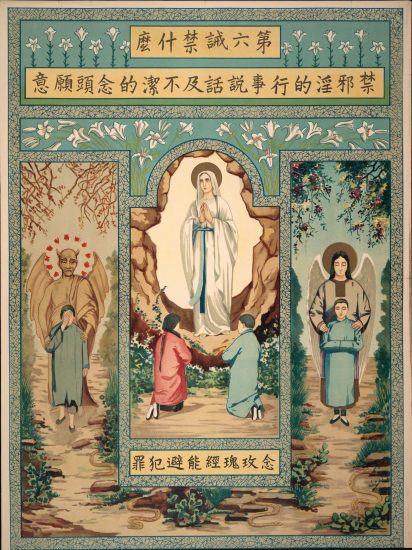Chinese Catholic Catechetical Posters
For the purpose of this project, I will be limiting my scope to solely focus on Chinese Catholic Catechetical posters that feature the Blessed Virgin Mary. These Chinese Catholic catechetical posters were lithographs, in contrast to the watercolor paintings of the elite sacred art posters. These lithographs were usually comprised of a single vertical sheet with a main central image or text, surrounded by text boxes or other images. The catechetical posters also featured a decorative border to mimic those of traditional Chinese hanging scrolls (1).
Both the catechetical posters and the “elite sacred art” were created by real Chinese artists, and thus were of great artistic quality and considered to be artworks. This should be understood in contrast to Protestant posters, which were not created by artists, and were intended to mimic the propaganda style of many political propaganda posters of that time period, such as those of the Communists (2). The artists of these Catholic catechetical posters emphasized traditional Chinese values such as filial piety and ecclesial duties (3).

Who is the Mother of Jesus?
Top: Who is the Mother of Jesus? It is Virgin Mary
Middle: Is Mary really a virgin? She truly is the perpetual virgin
How was it possible for a virgin to give birth to Jesus?
Bottom: Through the infinite power of God the Holy Spirit, Jesus was conceived in the most pure womb of His Blessed Mother without harm to Her virginity.
In this poster, the Blessed Virgin Mary is featured front and center–fittingly, since the topic of the poster is “Who is the Mother of Jesus?” One important thing to note about the portrayal of the Blessed Virgin Mary is that both she and Jesus are depicted as Chinese. This was done deliberately to shake the notion that the Catholic Church and its teachings were part of a foreign religion. Portraying Jesus and His Mother as Chinese would demonstrate to the audience that there was nothing incompatible with the Christian Gospel and Chinese culture (3).
The artwork above of the Blessed Virgin Mary holding the child Jesus is meant to imitate Western artworks of the Madonna and Child, although an interesting divergence from typical Western prototypes is the direction of the Child Jesus’s gaze. In Western artworks, the Child Jesus is usually depicted as gazing toward the viewer, or toward his mother. In this particular rendition, the Child Jesus is depicted gazing heaven-ward, perhaps in prayer. The artwork below is meant to be a Chinese adaptation of Western depictions of the Annunciation. We even know exactly which part of the Annunciation narrative this artwork is depicting, because of Western art traditions. Her hands are crossed in front of her, and her head is inclined slightly downwards, demonstrating her submission and acceptance of the angel’s message, and thus we know that it is specifically depicting her “Fiat,” her “yes” to God to become the Theotokos (4).
Depicting Jesus and Mary as Chinese
Depicting the Blessed Virgin Mary according to the racial and ethnic appearances of the audience was not something unique to the Chinese artists in China. For centuries prior in Western Europe, Jesus and the Blessed Virgin Mary were portrayed as white Anglo-Saxons, sometimes even featuring blonde hair and blue eyes–something entirely foreign to a Middle Eastern genome. In Mexico, the Blessed Virgin Mary was even recorded to have appeared as an indigenous Aztec woman. The Catholic Church affirmed the validity of this apparition, such that now the Blessed Virgin Mary is venerated under the title “Our Lady of Guadalupe” in honor of her appearance in Mexico. Thus it is clear that historically there is precedence within the Catholic Church for allowing art to be made of Jesus and the Blessed Virgin Mary depicted as of non-Jewish ethnicity. This policy is usually bounded by two informal requirements: first, that Jesus and the Blessed Virgin Mary be depicted as human (i.e. not a lizard), and second, that they are not meant to be similar to any person in particular.

What is Original Sin?
Top: Original Sin is the sin committed by our first parent Adam, and inherited by us.
Middle: [Adam and Eve] were driven out of Paradise and death entered the world
Bottom: After they were expelled, they had to toil to make a living
Right: God created man and woman
Left: God Himself told them to obey the commandment
Although the Blessed Virgin Mary is not mentioned in the text of this poster on Original Sin, it is extremely fitting that she would at least be depicted on the poster. She is found on the right side, easily identifiable by her blue robes and outstretched arms in the position traditionally called “Our Lady of Grace,” found on Miraculous Medals, and related closely to the dogma of the Immaculate Conception. For those unfamiliar with Catholic theology, in 1854 Pope Pius IX declared as the dogma of the Immaculate Conception that the Blessed Virgin Mary was conceived without original sin–that is, without inheriting the concupiscence of Adam and Eve’s first sin (5). Because of this, she is often referred to as the “New Eve,” as Jesus Christ is the “New Adam.”
Something interesting to note about the Blessed Virgin Mary’s “cameo” in this poster on original sin is that it’s just that–a cameo. Her presence is not mentioned in the text of the poster at all. This is interesting to note because it seems to almost deliberately admit for the opportunity for the viewer to ask questions to a Church authority–notably, what is the Blessed Virgin Mary doing on a poster about original sin? This seems to be reminiscent of ancient and Medieval Catholic paintings, which were used in the catechetical instruction of the illiterate. They depicted fundamental truths of Catholic theology using heavy symbolism, such that even someone illiterate would be able to get the basic gist of the Gospel message, but were certainly not meant to be taken on their own without the instruction of a catechist.

Which person of the Trinity became man?
Top: Which one of the Blessed Trinity became man? God the Son, the second Person of the Blessed Trinity, became incarnate and was made man.
Center: How did God become man? God became man by choosing the Virgin Mary to be His Mother.
Bottom: How did Jesus atone for the sins of men? Jesus atoned for the sins of men by accepting His Passion willingly, and by dying nailed to a cross.
Left: Original Sin
Right: Sins committed
In this poster, the Blessed Virgin Mary is depicted in the top picture spreading her arms out over the newborn Jesus Christ. She is clothed in pink and blue, one color schema that I have noticed is used for identifying the Blessed Virgin Mary in paintings, the other being blue and white. It is interesting to note that although it seems to be depicting a scene soon after the birth of Christ, Jesus is not depicted in a manger, but rather on a bed of hay on the ground. Perhaps this is an instance of presenting Gospel stories in the setting of China, but I am not certain.

What does the Sixth Commandment Forbid?
Top: What does the sixth commandment forbid?
Second line: The sixth commandment forbids all words and actions of adultery and unclean thoughts and ideas.
Bottom: You can avoid committing sin by praying the Rosary.
The Rosary is perhaps the most popular and famous devotion in Latin Catholicism, so it is no surprise that the audience is exhorted to pray the Rosary to avoid sin. But beyond that, the Blessed Virgin Mary was seen as an exemplary figure in chastity and purity, because the Catholic Church holds as dogma that she remained a virgin even after giving birth to Jesus Christ. There is even a tradition in the Catholic Church that she was originally a vowed temple virgin, similar to a cloistered nun (but still with major differences), which Catholics celebrate on the feast of the Presentation of Mary on November 21 every year.
Works Cited
(1) Wong, Stephanie M., Visions of Salvation: Chinese Christian Posters in an Age of Revolution, 2023. edited by Daryl Ireland. Chapter 8: Roman Catholicism: Painting, Printing, and Selling Morality in Modern China, page 192
(2) Ibid., page 201
(3) Ibid., page 187
(4) Williamson, Beth. “The Virgin Mary.” In Christian Art: A Very Short Introduction. Oxford, 2004; online edn, Oxford Academic, 24 Sept. 2013. https://doi.org/10.1093/actrade/9780192803283.003.0002
(5) Adams, Marilyn McCord. “The Immaculate Conception of the Blessed Virgin Mary: A Thought-Experiment in Medieval Philosophical Theology.” Harvard Theological Review 103, no. 2 (April 1, 2010): 133–59. https://doi.org/10.1017/s0017816010000520.
